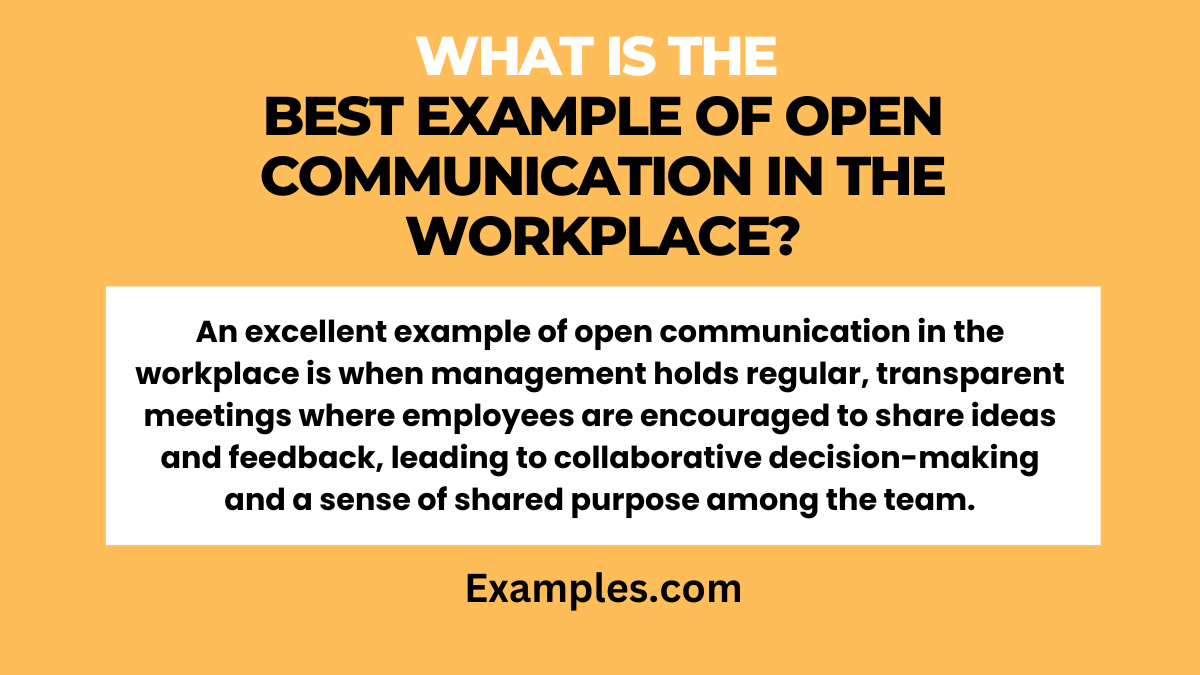19+ Open Communication in the Workplace Examples
Open communication in the workplace is a critical factor for fostering a collaborative and productive environment. This complete guide, brimming with real-world communication examples, illuminates the path to achieving better employee engagement and effective teamwork. Through practical scenarios and strategies, we explore how open dialogue can resolve common workplace challenges, enhance leadership communication, and strengthen organizational dynamics. Dive into this guide to unlock the secrets of successful business communication and transform your workplace interactions.
Download Open Communication in the Workplace in PDFWhat is Open Communication in the Workplace? – Meaning

Open communication in the workplace refers to an environment where employees freely and honestly exchange ideas, opinions, and information. It’s a transparent way of interacting that encourages sharing thoughts without fear of judgment or negative consequences. This type of communication fosters trust and clarity, allowing for better collaboration and problem-solving. Essential in leadership communication and employee engagement, open communication is key to a thriving and inclusive work culture.
What is the Best Example of Open Communication in the Workplace?

The best example of open communication in the workplace is regular team meetings where every member feels valued and heard. In such meetings, employees are encouraged to share their ideas, concerns, and feedback openly. Leaders actively listen and acknowledge the contributions of each team member, creating an atmosphere of respect and inclusivity. This practice not only empowers employees but also fosters innovative problem-solving and decision-making. Such open dialogue exemplifies effective office communication and employee engagement, leading to a more collaborative and productive work environment.
20 Examples of Open Communication in the Workplace

Open communication in the workplace is pivotal for creating a harmonious and efficient work environment. This guide offers 20 unique examples showcasing various forms of open communication. Each example demonstrates how transparent and honest exchanges can improve employee engagement, resolve conflicts, and enhance overall business communication. These scenarios will provide valuable insights into fostering a culture of openness, ensuring every voice is heard and valued in your organization.
- Weekly Team Check-ins: Regular team meetings encourage an ongoing dialogue about work progress and challenges.
Example: “In today’s meeting, let’s update each other on our projects and discuss any support we might need.” - Feedback Sessions: Constructive feedback sessions help identify areas for improvement and personal development.
Example: “During our feedback session, I’d like to explore how we can enhance our project outcomes together.” - Idea Brainstorming Sessions: Brainstorming sessions create a platform for innovative and creative problem-solving.
Example: “Let’s brainstorm solutions for our new campaign, where every idea will be considered.” - One-on-One Meetings with Managers: These meetings provide a private space for employees to discuss their career and personal concerns.
Example: “In our one-on-one, let’s talk about your career goals and how I can support your growth.” - Anonymous Suggestion Box: An anonymous channel for employees to voice their opinions and suggestions without fear of repercussion.
Example: “If you have any suggestions for workplace improvements, feel free to use the anonymous suggestion box.” - Conflict Resolution Meetings: Facilitated discussions to address and resolve workplace conflicts in a constructive manner.
Example: “Let’s use this meeting to openly discuss the conflict and work towards a mutually agreeable solution.” - Employee Engagement Surveys: Surveys to gather feedback on workplace environment and employee satisfaction.
Example: “Please provide your honest feedback in the engagement survey to help us improve our work environment.” - Training Sessions on Effective Communication: Training to enhance employees’ communication skills for better workplace interactions.
Example: “Join the communication skills training to learn how to communicate more effectively with your team.” - Open-Door Policy: Encouraging employees to freely approach their superiors with ideas, concerns, or feedback.
Example: “Remember, I have an open-door policy. You’re always welcome to come and talk about any concerns.” - Team Building Activities: Activities designed to improve team collaboration and communication.
Example: “Our next team-building activity is focused on enhancing our communication and teamwork skills.” - Regular Company Updates: Keeping employees informed about company news, changes, and developments.
Example: “We’ll be providing regular updates on the company’s progress and upcoming changes in our monthly meetings.” - Departmental Cross-Communication: Encouraging dialogue and collaboration between different departments.
Example: “In our cross-departmental meeting, let’s align our goals and discuss how we can work together more effectively.” - Mentorship Programs: Pairing employees with mentors for guidance and to facilitate open communication.
Example: “Your mentor is here to offer guidance and discuss any professional challenges you’re facing.” - Encouraging Questions in Meetings: Creating a welcoming environment for employees to ask questions and seek clarifications.
Example: “Feel free to ask any questions during the meeting to ensure everyone is on the same page.” - Transparent Decision-Making Processes: Involving employees in decisions to provide transparency and foster a sense of ownership.
Example: “We want your input on these decisions. Your perspectives are valuable to us.” - Celebrating Successes Openly: Acknowledging and celebrating team and individual achievements in the workplace.
Example: “Let’s take a moment to celebrate our team’s achievements and discuss what we learned from this project.” - Open Forums for Discussion: Hosting forums for employees to discuss and share ideas on various topics.
Example: “Our open forum is a space for you to discuss any ideas or concerns about our work environment.” - Flexibility in Work Arrangements: Discussing and accommodating different work arrangement needs.
Example: “Let’s discuss how we can make your work arrangement more flexible to suit your needs.” - Health and Wellness Programs: Offering programs focused on employee health and wellness.
Example: “Our wellness program includes various activities and resources. Let’s talk about how you can benefit from it.” - Leadership’s Regular Communication: Leaders regularly updating and communicating with their teams.
Example: “I will be providing regular updates on our team’s progress and am available for any discussions or concerns.”
These examples, accompanied by clear communication sentences, illustrate the different ways open communication can be fostered in the workplace, leading to enhanced collaboration, employee engagement, and a positive work culture.
Why is Open Communication Important in the Workplace
Open communication in the workplace is crucial for fostering a productive and positive work environment. It allows for clear and effective exchange of ideas, feedback, and concerns, leading to better decision-making and problem-solving. Open communication strengthens team dynamics, encourages employee engagement, and reduces misunderstandings, which can often lead to conflicts. It also enhances leadership communication, as leaders who communicate openly are seen as more trustworthy and approachable. Moreover, open communication can increase job satisfaction and employee morale, as team members feel valued and heard. In essence, it’s a key factor in driving organizational success and building a strong, collaborative work culture.
10 Ways to Encourage Open Communication in the Workplace
Encouraging open communication in the workplace is vital for fostering a culture of trust, collaboration, and increased employee engagement. An environment where thoughts and ideas can freely flow not only enhances business communication but also strengthens the overall organizational health. Here are 10 effective ways to cultivate an atmosphere of open dialogue and transparency within your team or company.
- Establish a Culture of Transparency: Lead by example to create an environment where honesty and openness are valued.
- Encourage Regular Feedback: Implement feedback mechanisms where employees can freely share their thoughts and suggestions.
- Facilitate Open Meetings: Conduct meetings where everyone is encouraged to speak and contribute ideas.
- Implement an Open-Door Policy: Allow employees to feel comfortable approaching leadership with their concerns and ideas.
- Provide Communication Training: Offer training sessions to enhance communication skills among employees.
- Recognize and Reward Open Communication: Acknowledge those who practice open communication, thus incentivizing others.
- Create Collaborative Spaces: Designate areas in the office where employees can gather informally to share ideas and collaborate.
- Encourage Active Listening: Train leaders and employees in the art of active listening to ensure everyone feels heard and understood.
- Use Multiple Communication Channels: Utilize various platforms like emails, intranet, and meetings to cater to different communication styles.
- Address Conflicts Openly: When conflicts arise, address them transparently and constructively, showing that open communication is key to resolution.
By implementing these strategies, a workplace can significantly enhance open communication, leading to a more engaged, efficient, and harmonious work environment.
How to Maintain Open Communication in the Workplace
Maintaining open communication in the workplace is vital for nurturing a positive and efficient work environment. To achieve this, it’s essential to establish regular communication in the workplace, like weekly team meetings and one-on-one discussions, ensuring a consistent flow of information. Creating a safe space for employees to voice their thoughts openly and without fear is crucial. Encourage a culture of feedback, both positive and constructive, as it reinforces the importance of open dialogue. Leadership plays a key role in maintaining open communication; leaders should exemplify transparency and approachability in their interactions.
Implementing training programs can enhance communication skills among employees, further supporting open dialogue. Recognizing and celebrating instances of successful open communication can help embed it into the company’s culture. Moreover, adapting communication strategies to meet the changing dynamics of the workforce is essential. Including resources like Communication Style for Managers and Communication Style for Leaders can provide additional guidance for maintaining effective communication.
Benefits of Open Communication in the Workplace
The benefits of open communication in the workplace are multifaceted. It leads to improved problem-solving and decision-making as a result of the diverse ideas and perspectives shared. Enhanced team collaboration and increased productivity are direct outcomes of effective office communication. Open communication ensures employees feel valued and involved, significantly boosting job satisfaction and morale. It fosters a culture of trust and respect, essential for employee engagement.
This type of communication environment also reduces misunderstandings and conflicts, leading to a more harmonious workplace. Additionally, open communication is key to employee retention, as staff are more likely to stay in an environment where they feel heard and respected. Lastly, it contributes to the continuous growth and learning of an organization. Feedback and innovative ideas lead to improvements and adaptations in business strategies. Integrating concepts like Communication Styles in the Workplace and How to Improve Communication Style can offer further insights into reaping the benefits of open communication.
How to Promote Honest and Open Communication in the Workplace
Promote honest and open communication by establishing regular team meetings, encouraging feedback, and implementing an open-door policy for approachable leadership.
Why is Open Communication Important for Employees?
Open communication is crucial for employees as it enhances trust, improves collaboration, and increases job satisfaction by making them feel valued and heard.
How Do You Demonstrate Open Communication in the Workplace?
Demonstrate open communication by actively listening, engaging in transparent discussions, sharing information freely, and encouraging diverse opinions and feedback.
What is the Open Communication Policy in the Workplace?
An open communication policy in the workplace entails a culture where employees can freely share ideas, feedback, and concerns without fear of negative repercussions.
Communication Processes in Workplace Meetings likely explores the dynamics and effectiveness of communication within the context of workplace meetings. It may examine factors such as communication styles, participant engagement, decision-making processes, and the impact of these meetings on organizational goals and employee relations. Understanding these processes is crucial for enhancing the efficiency and productivity of meetings, a fundamental aspect of organizational communication. For detailed insights, you should directly review the article on the NCBI website.
Open communication in the workplace is a cornerstone for building a thriving, collaborative, and transparent work environment. It not only fosters trust and respect among employees but also enhances overall productivity and employee satisfaction. By prioritizing honest dialogue, encouraging diverse perspectives, and maintaining continuous feedback channels, organizations can cultivate a dynamic and harmonious workplace conducive to growth and success.



